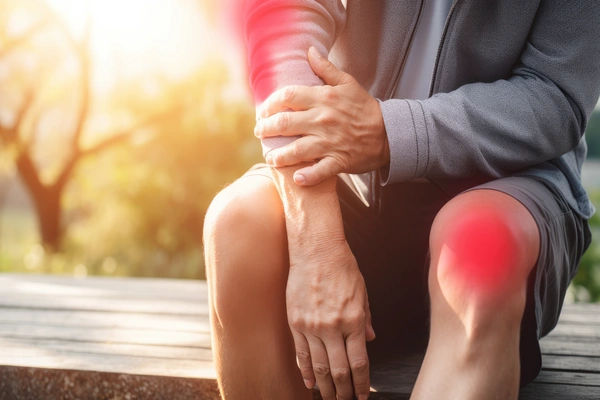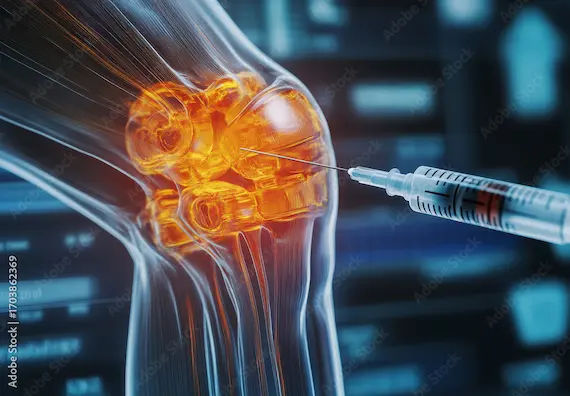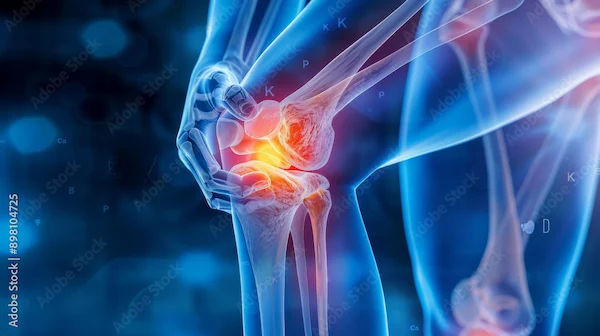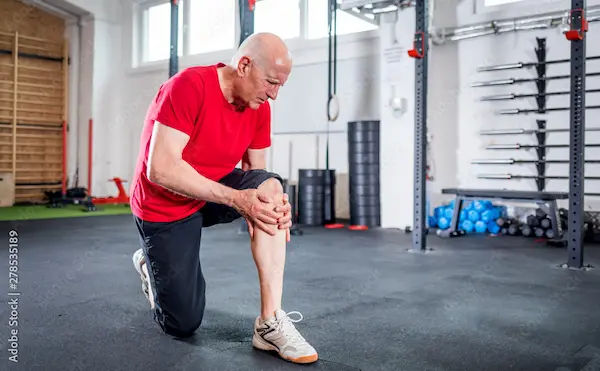Navigating Joint Pain in Your Golden Years: A Senior's Guide to Healthy Joints
Know about the joint pain, causes, common joint problems in old-age, recognising the signs & symptoms, effective treatment options and more.


Introduction
Entering your golden years should be a time of relaxation and enjoyment, but for many, it's overshadowed by the persistent ache and stiffness of joint problems. If you find yourself hesitating before standing up or avoiding activities you once loved, you're not alone. Joint pain in old age is incredibly common, but it's not an inevitable sentence to a life of discomfort. We'll demystify why our joints change over time, explore the most common conditions like osteoarthritis and rheumatoid arthritis, and provide a comprehensive roadmap for management and relief. From simple lifestyle tweaks and effective exercises to understanding medical treatments and when to seek help, our goal is to help you reclaim your mobility and reduce pain.
Why Do Joints Ache More as We Age?
Ageing is a natural process, and our joints, which have supported us for decades, naturally show signs of use. Understanding the "why" behind the ache is the first step toward effective management. The primary reasons are mechanical wear, systemic inflammation, and the often-overlooked loss of muscle support.
The Wear-and-Tear of Osteoarthritis
Imagine the cartilage cushioning the ends of your bones as a shock absorber in a car. Over a lifetime of use, this smooth, slippery tissue can gradually wear down. This is the essence of osteoarthritis (OA), the most common joint problem in older adults. As cartilage deteriorates, bones begin to rub against each other, causing pain, swelling, and a loss of flexibility. Factors like genetics, previous injuries, and repetitive stress all contribute to this process. It's a classic case of wear-and-tear, but its progression can be influenced.
Consult a Top Joint Specialist for Personalised Advice
The Role of Inflammation: Rheumatoid Arthritis and Gout
Not all joint pain is due to simple wear. Some conditions involve the body's immune system mistakenly attacking the joints. Rheumatoid arthritis (RA) is a chronic inflammatory disorder that primarily targets the lining of the joints (synovium), causing painful swelling that can eventually lead to bone erosion and joint deformity. Unlike OA, which is often localised, RA typically affects joints symmetrically (both wrists, both knees). Gout is another inflammatory condition caused by a buildup of uric acid crystals in a joint, leading to sudden, severe attacks of pain, redness, and tenderness, often in the big toe.
The Silent Contributor: Loss of Muscle Mass (Sarcopenia)
A critical but frequently underestimated factor is sarcopenia, the age-related loss of muscle mass and strength. Muscles act as natural braces for our joints. Strong thigh muscles, for instance, stabilise the knee joint, absorbing impact and reducing stress on the cartilage. As we lose muscle, our joints bear more of the load, accelerating wear and tear and increasing the risk of pain and injury. Combating sarcopenia through strength training is a powerful strategy for managing joint problems in the elderly.
Common Joint Problems Affecting Older Adults
While many conditions can cause joint discomfort, a few are particularly prevalent in later life.
Osteoarthritis: The Most Common Culprit
Often called "degenerative joint disease," osteoarthritis is the leading cause of joint pain in seniors. It most commonly affects the hands, knees, hips, and spine. Symptoms include deep, aching pain, stiffness (especially after rest or in the morning), and a grating sensation when the joint is used. According to the Arthritis Foundation, over 32.5 million U.S. adults are affected by OA.
Rheumatoid Arthritis: An Autoimmune Attack
RA is a systemic disease, meaning it can affect the whole body. It often starts between ages 30 and 60, but can continue and worsen with age. Key differences from OA include prolonged morning stiffness (often lasting more than 30 minutes), swelling and warmth in the joints, and symptoms like fatigue and fever. Early diagnosis and treatment are crucial to slow its progression.
Gout: When Crystals Cause Agony
Gout attacks, or "flare-ups," can be excruciating. They often start suddenly at night. Risk factors include a diet rich in red meat and shellfish, obesity, certain medications, and family history. Managing gout involves both treating acute attacks and making long-term lifestyle changes to lower uric acid levels.
Osteoporosis and Its Link to Joint Health
While osteoporosis itself (porous bones) doesn't cause joint pain, it's a common comorbidity. Weakened bones from osteoporosis can change posture and gait, placing abnormal stress on joints and potentially exacerbating conditions like OA. Furthermore, fractures from osteoporosis, particularly in the hip or wrist, can severely impact joint function and mobility.
Recognising the Signs: Symptoms Beyond the Ache
Joint problems manifest in more ways than just a dull ache. Being aware of the full spectrum of symptoms can lead to earlier intervention.
Early Warning Signs You Shouldn't Ignore
* Stiffness: Difficulty moving a joint after periods of inactivity, like getting out of bed or a chair.
* Swelling: Mild inflammation around a joint that may feel warm to the touch.
* Reduced Range of Motion: Inability to fully bend or straighten a joint, such as your knee or elbow.
* Tenderness: Discomfort when applying light pressure to the joint or the area around it.
Symptoms That Warrant a Doctor's Visit
If you experience any of the following, it's important to seek medical advice. If symptoms like severe pain, sudden swelling, or joint deformity appear, consult a doctor online with Apollo24|7 for further evaluation.
* Severe, unrelenting pain that interferes with sleep or daily activities.
* Sudden, significant swelling or redness.
* Joint deformity.
* Inability to use the joint or bear weight.
* Symptoms accompanied by fever, which could indicate an infection.
Effective Management and Treatment Strategies
Managing joint problems is often a multi-faceted approach tailored to the individual's specific condition, severity, and overall health.
Medication Management for Pain and Inflammation
Over-the-counter pain relievers like acetaminophen can help with mild to moderate pain. Nonsteroidal anti-inflammatory drugs (NSAIDs) like ibuprofen or naproxen can reduce both pain and inflammation. For more severe cases, a doctor may prescribe stronger medications, including corticosteroids or disease-modifying antirheumatic drugs (DMARDs) for rheumatoid arthritis.
The Power of Physical Therapy and Exercise
This is a cornerstone of non-surgical management. A physical therapist can design a personalised program to strengthen supporting muscles, improve flexibility, and increase the range of motion.
Best Low-Impact Exercises for Seniors
* Swimming or Water Aerobics: The buoyancy of water supports your weight, relieving stress on joints while providing resistance for strength training.
* Cycling (Stationary or Recumbent): Excellent for improving knee and hip mobility without high impact.
* Tai Chi: This gentle martial art improves balance, flexibility, and strength through slow, flowing movements.
Strength Training: Your Joints' Best Friend
Building muscle is like building a custom-made brace for your joints. Focus on exercises that target the muscles around your most problematic joints. For example, leg lifts and hamstring curls can significantly support weak knees.
Lifestyle Modifications: Diet, Weight, and Daily Habits
* Weight Management: Every pound of excess weight puts about four pounds of extra pressure on your knees. Losing even a small amount of weight can dramatically reduce pain.
* Anti-Inflammatory Diet: Focus on a Mediterranean-style diet rich in fruits, vegetables, whole grains, and healthy fats (like olive oil and fish rich in omega-3s).
* Assistive Devices: Don't shy away from using a cane, walker, or jar opener. These tools reduce joint stress and help prevent falls.
Surgical Options: When Joint Replacement is Considered
When conservative treatments no longer provide adequate relief, surgery may be an option. Joint replacement surgery, particularly for hips and knees, is highly successful at relieving pain and restoring function in advanced osteoarthritis. If your condition does not improve after trying these methods, book a physical visit to an orthopaedic specialist with Apollo24|7 to discuss all available options.
Proactive Prevention: Slowing Down Joint Degeneration
It's never too late to adopt habits that protect your joints. Staying active, maintaining a healthy weight, practising good posture, and avoiding repetitive high-impact activities can all help preserve joint health and function well into your senior years.
Conclusion
Living with joint problems in old age can be challenging, but it's important to remember that you have significant control over your comfort and mobility. By understanding the underlying causes, recognising the symptoms early, and actively engaging in a comprehensive management plan that includes appropriate exercise, weight control, and medical support, you can effectively reduce pain and stiffness. The goal is not to eliminate all signs of ageing but to manage them so you can continue to enjoy a vibrant, active life. Don't let joint pain dictate your activities. Take the insights from this guide, discuss them with your healthcare provider, and take the first step towards moving with greater ease and confidence. Your golden years deserve to be lived to the fullest.
Consult a Top Joint Specialist for Personalised Advice
Consult a Top Joint Specialist for Personalised Advice

Dr. Sudipta Saha
Orthopaedician
8 Years • MBBS,(D. Ortho)
Kolkata
VDC Clinic, Kolkata

Dr. Manoj Dinkar
Orthopaedician
15 Years • MBBS, Dip (Orthopaedics)
New Delhi
THE DOCTORS NESST, New Delhi

Dr. Vishruta A V
Orthopaedician
5 Years • MBBS MS Orthopaedics
Bengaluru
Apollo Clinic, JP nagar, Bengaluru

Dr. Sushruth J
Orthopaedician
5 Years • MBBS, MS (ORTHOPEDICS),Fellowship in Arthroplasty,FRGUHS – Spine surgery,FIFA Diploma in Football Medicine
Bengaluru
Apollo Clinic, JP nagar, Bengaluru

Dr Rameshwari Saminathan
Orthopaedician
9 Years • MBBS MS
Bengaluru
Apollo Clinic, JP nagar, Bengaluru
Consult a Top Joint Specialist for Personalised Advice

Dr. Sudipta Saha
Orthopaedician
8 Years • MBBS,(D. Ortho)
Kolkata
VDC Clinic, Kolkata

Dr. Manoj Dinkar
Orthopaedician
15 Years • MBBS, Dip (Orthopaedics)
New Delhi
THE DOCTORS NESST, New Delhi

Dr. Vishruta A V
Orthopaedician
5 Years • MBBS MS Orthopaedics
Bengaluru
Apollo Clinic, JP nagar, Bengaluru

Dr. Sushruth J
Orthopaedician
5 Years • MBBS, MS (ORTHOPEDICS),Fellowship in Arthroplasty,FRGUHS – Spine surgery,FIFA Diploma in Football Medicine
Bengaluru
Apollo Clinic, JP nagar, Bengaluru

Dr Rameshwari Saminathan
Orthopaedician
9 Years • MBBS MS
Bengaluru
Apollo Clinic, JP nagar, Bengaluru
More articles from Joint Pain
Frequently Asked Questions
1. What is the main difference between osteoarthritis and rheumatoid arthritis?
.Osteoarthritis is a mechanical 'wear-and-tear' condition where joint cartilage breaks down. Rheumatoid arthritis is an autoimmune disease where the body's immune system attacks the joints, causing inflammation. OA pain typically worsens with activity, while RA often causes prolonged morning stiffness and systemic symptoms like fatigue.
2. Are there any natural remedies for arthritis pain relief?
Some people find relief with supplements like glucosamine and chondroitin, though scientific evidence is mixed. Topical capsaicin creams can help by blocking pain signals. Practices like turmeric (curcumin) consumption and acupuncture may also provide relief for some, but it's important to discuss any new remedies with your doctor first.
3. What are the best exercises for knee pain in the elderly?
Excellent low-impact exercises for seniors with knee pain include swimming, water aerobics, stationary cycling, and leg strengthening exercises like straight-leg raises and hamstring curls. These activities build supporting muscles without jarring the joint.
4. When should I consider joint replacement surgery?
Surgery is typically considered when conservative treatments (medication, physical therapy, lifestyle changes) no longer control the pain, and the joint deterioration significantly impacts your quality of life, making daily activities like walking or climbing stairs unbearable.
5. Can cracking my knuckles cause arthritis?
No, studies have not found a link between knuckle cracking and osteoarthritis. The popping sound is caused by gas bubbles bursting in the synovial fluid. However, habitual knuckle cracking may lead to reduced grip strength or swelling in the hands for some individuals.




